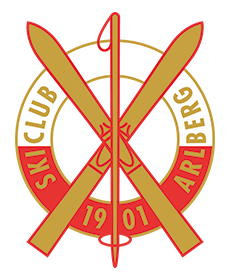Tradition & History
On 3 January 1901, six friends set out from St. Anton am Arlberg through the fresh powder snow to St. Christoph am Arlberg – dressed in loden clothes, on simple slats, with heavy boots on their feet and one pole each. After arriving at the Hotel Hospiz at 1,800 metres above sea level, they took a break that resulted in a fateful decision. They would found the Ski-Club Arlberg.
The following entry by founding member and local councillor Adolf Rybizka can still be read at the guest book of Hotel Hospiz: “Enthused by nature, dedicated to sport, motivated by the necessity to establish a modest meeting point for the friends of this noble pleasure, the spontaneously participating excursionists felt moved to found the ‘Ski-Club Arlberg’!” St. Christoph, 3. Jänner 1901
The entry was signed by the founding members Carl and Adolf Schuler, Dr. Adolf Rybizka, Oswald Trojer, Josef Schneider, Ferdinand Beil, Dr. F. Gerstel and Lisl Trojer.
Only three years after its inception, the Ski-Club organised its first public ski race on 5th and 6th January 1904. A premiere for the Alpine region! The routing for this competition was meticulously planned out and took participants from the Ulmer Hütte via the Schindlerferner to the Arlensattel, from there up the Galzig, then down to St. Christoph and on to St. Anton am Arlberg. Today, one can hardly imagine which hardships these ski pioneers had to overcome! Carrying heavy sport gear up the mountain, the skiers had to struggle through the deep snow. At the arrival of the twentieth century, modern-day cableways, ski lifts and perfectly groomed slopes were still decades away! More than a hundred years later, the Ski-Club Arlberg ranges among the most significant ski clubs in all of Europe.

HISTORICAL CLUB BADGE
Since the inception of Ski-Club Arlberg more than hundred years ago, many things have changed, but the club badge and the emblem for the elite training centre remained the same, just as the medical student Fritz Gerstel first designed it, displaying a circle, two crossed skis and a single pole.
The club has not only produced numerous world-class athletes, but repeatedly set new standards for the development of Alpine skiing. As a pioneering organisation it also played an important role in establishing the Austrian and German skiing associations. In 1928, SCA organised the very first Kandahar race that is still being held today as part of the FIS Alpine Ski World Cup, not only in St. Anton am Arlberg, but also in other traditional locations scattered throughout the Alps. Lest not forget, Stuben-born Hannes Schneider established the very first ski school and helped develop the famous Arlberg technique. This innovation, also known as stem-turn, was the precursor to the modern-day parallel-turn.
